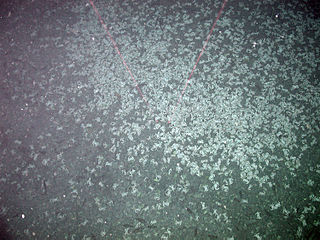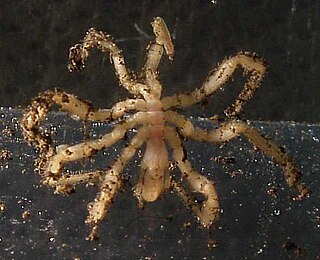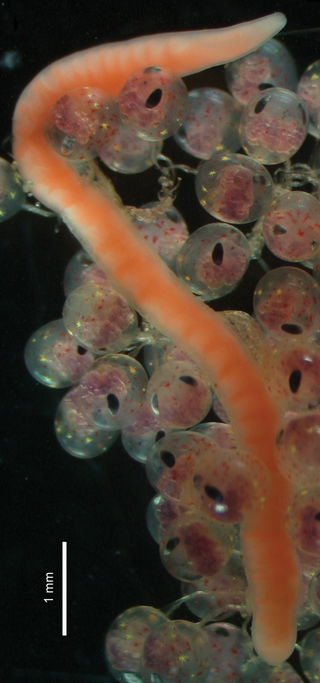
Bigfin squids are a group of rarely seen cephalopods with a distinctive morphology. They are placed in the genus Magnapinna and family Magnapinnidae. Although the family was described only from larval, paralarval, and juvenile specimens, numerous video observations of much larger squid with similar morphology are assumed to be adult specimens of the same family.

Aspidites is a genus of pythons endemic to Australia. The name can be translated as "shield bearer" and pertains to the symmetrically shaped head scales. Currently, two species are recognized.
Uropeltis is a genus of nonvenomous shield tail snakes endemic to Peninsular India. As of 2022, 26 species are recognized as being valid.

Kiwa is a genus of marine decapods living at deep-sea hydrothermal vents and cold seeps. The animals are commonly referred to as "yeti lobsters" or "yeti crabs”, after the legendary yeti, because of their "hairy" or bristly appearance. The genus is placed in its own family, Kiwaidae, in the superfamily Chirostyloidea.

Pluteus is a large genus of fungi with over 300 species. They are wood rotting saprobes with pink spore prints and gills that are free from the stem.

Jean de Segonzac is an American director, screenwriter and cinematographer who has worked in documentaries and television programs. Most of his work has been in gritty, cinéma vérité-style law enforcement TV dramas.

The Bythograeidae are a small family of blind crabs which live around hydrothermal vents. The family contains 16 species in six genera. Their relationships to other crabs are unclear. They are believed to eat bacteria and other vent organisms. Bythograeidae are a monophyletic, sister taxon of the superfamily Xanthoidea which split to inhabit hydrothermal vents around the Eocene.
Xenotyphlops is a genus of snakes, the only genus of the family Xenotyphlopidae, comprising two species found only in Madagascar. These snakes are also known as the Malagasy blind snake.
Harttia is a genus of armored catfishes native to South America.

Munidopsis serricornis is a species of squat lobster. It is widely distributed in the world's oceans, being found in the eastern Atlantic Ocean, the western Atlantic Ocean, and the Indo-Pacific. It grows up to a carapace length of 20 millimetres (0.8 in).

Munidopsis is a genus of squat lobster. It is the second largest of all the genera of squat lobsters, after Munida, with over 200 species. Its members are mainly found on continental slopes and on abyssal plains. A few fossil species are also known, including specimens from the Campanian (Cretaceous).
Antennoseius is a genus of mites in the family Ascidae. As of 2021, it comprised 59 species mostly in subgenera Antennoseius and Vitzthumia, as well as six species not assigned to a subgenus.
Andreacarus voalavo is a parasitic mite found on the Malagasy rodent Voalavo gymnocaudus. First described in 2007, it is closely related to Andreacarus gymnuromys and Andreacarus eliurus, which are found on other Malagasy rodents. The length of the idiosoma, the main body, is 630 to 670 μm in females and 450 to 480 μm in males. Unlike A. eliurus, this species lacks distinct sternal glands between two lyrifissures on the lower part of the female body. The pilus dentilis, a sensory organ on the chelicera, is serrate, which distinguishes it from A. gymnuromys. Females of A. gymnuromys also have a less ornamented sternal shield and shorter setae (bristles) on the upperparts.

Cyanagraea praedator is a species of crab that lives on hydrothermal vents, and the only species in the genus Cyanagraea.
Vulcanoctopus hydrothermalis is a small benthic octopus endemic to hydrothermal vents.
Thymopides is a genus of deep-water lobsters, comprising the two species Thymopides grobovi and Thymopides laurentae.

Xylophaga is a genus of bivalves in the family Pholadidae.
Richard E. Young is a teuthologist. He is an Emeritus Professor of Oceanography at the University of Hawaii's School of Ocean and Earth Science and Technology.

Sericosura is a genus of sea spiders in the family Ammotheidae. Species within this genus have been found living at depths from 106 to 3,690 meters below sea level.

Carcinonemertidae is a family of worms belonging to the order Hoplonemertea.










